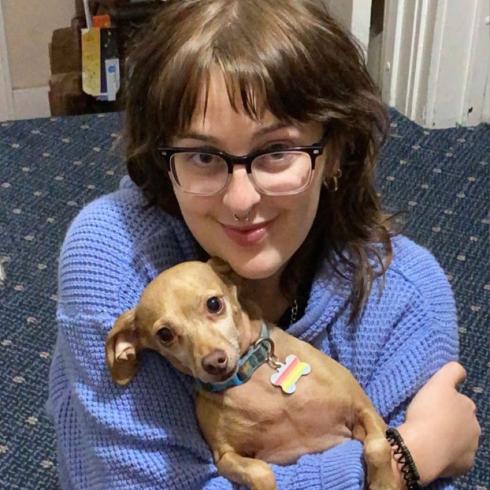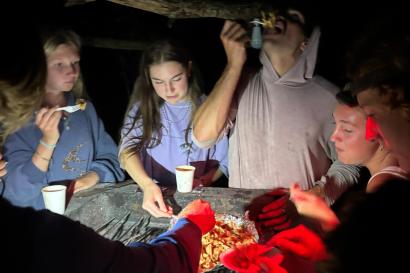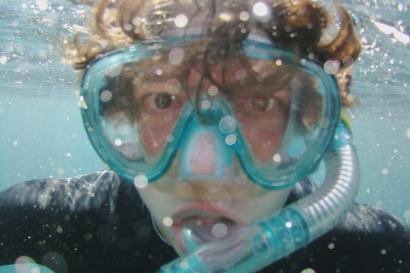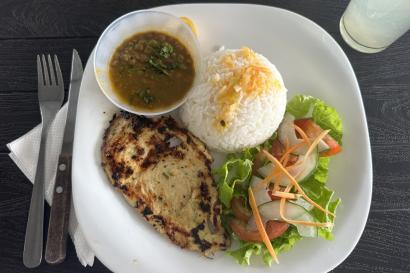I first heard the legend of the guayaba (guava) recounted during a hike through the forest at Hacienda Guadalupe, a farm up in the Highlands of San Cristóbal island. Our tour guide began the legend in a hushed whisper, about a mile into our hike. It was the first we had ever heard of Manuel Julián Cobos, the infamous first settler and founder of the torturous Hacienda El Progresso. The legend of the guayaba is more than just a tale; it was the first glimpse we got into the dark penal history of the island we had been living on blindly for months. I first heard the legend of the guayaba (guava) recounted during a hike through the forest at Hacienda Guadalupe, a farm up in the Highlands of San Cristóbal island. Our tour guide began the legend in a hushed whisper, about a mile into our hike. It was the first we had ever heard of Manuel Julián Cobos, the infamous first settler and founder of the torturous Hacienda El Progresso. The legend of the guayaba is more than just a tale; it was the first glimpse we got into the dark penal history of the island we had been living on blindly for months.
Though El Progresso was the first inhabited region of San Cristóbal island, very few tourists are drawn to the area, and the history of the tyrannical Manuel Julián Cobos is made invisible in the popular narrative of the archipelago. While I won’t recount the entire history here, for the sake of brevity (to find a more in-depth history, check out the sources I have linked), let it be known that Cobos was a horrible, evil man. He founded San Cristóbal on the labor of enslaved prisoners sent from mainland Ecuador, and made a fortune from their suffering. Whenever you mention the name “Cobos” to a local of San Cristóbal, they shudder in horror.
Yet, there is very little recorded history of his terror. While there are several myths that frame the Galápagos as a hell-to-paradise arc (the various legends of Floreana Island), the main narratives about the Galápagos focus on the hegemonic Darwin lore. Much of the human history is brushed past in favor of finches, or Lonesome George.
There are several valuable anthro-historical sites on San Cristóbal, such as the archeological site where the remains of Cobos’ plantation lie. It is in the backyard of Santos Livipoma, where a wall of soil containing layers of bottles, coins, and ceramic fall each time it rains. All of these artifacts are crucial to evoke an understanding of the tragic history of the island, yet there is currently no institutional efforts in process to preserve them. Santos keeps them in a shoebox. There are hundreds of thousands of dollars funneled into the preservation of endemic species, and yet, almost no care taken to preserve the history of the people who live here and their descendants who uphold the tourism industry today.
My goal in sharing this legend on the internet is to shift the perception of the Galápagos as an untouched ecological haven to a more nuanced truth: the Galápagos is the product of a sinister capitalist greed. The Galápagos is not special in the way it was created. The booming tourism industry of the Galápagos today was built on the backs of the enslaved, just like the rest of the world economy.
In a world where the written word declares your existence to the world, I want to put this legend into existence online to show that the history of El Progresso matters. I want to use the platform I have through IES Abroad to share this legend publicly, so the human history of the Galápagos does not drift away in silence. I want to help to begin the process of global remembering.
Courtesy of Galápagos naturalist and local, Doménica Guerrero, I have included the original text of the legend of the guayaba in Spanish, a translation in English from Deepl translator, as well as an audio file of Doménica giving breath to the text. This text is an excerpt from “Leyendas de Galápagos,” which, According to Doménica, is very difficult to find. Only a few people on the island are in possession of it.
The following is an excerpt from “Leyendas de Galápagos” by Enrique Freire G.
Original Spanish
Hasta la actualidad los especialistas no encuentran la manera de erradicar la guayaba que ha invadido gran parte de la isla San Cristóbal.
Los caminos de la zona rural de la isla están rodeados de bosques de esta planta frutal, que los colonos miran con desprecio. Para ellos esta planta obstaculiza las tierras para cultivos y además, les recuerda el trágico evento de una época de esclavitud y barbarie pues la guayaba es una planta maldecida.
De acuerdo a lo que cuentan los abuelos, se debe a la siguiente historia:
De vez en cuando llegaba desde el continente el buque Estrella del Mar, cuando atracaba en la playa era motivo de múltiples espectativas entre los esclavos de la isla, ya sea porque les esperaba el duro trabajo de conducir pesados cargamentos hacia la hacienda “El Progreso” o porque llegaban nuevas remesas de deportados.
Cuando comenzaron las tareas de desembarque de entre los numerosos cargamentos, había uno que se consideraba especial y debía ser tratado con cuidado. Era portador de una planta de guayaba, de las que abundan en las costas ecuatorianas, pero muy estimada para el patrón de la hacienda, Manuel Julián Cobos.
La planta fue sembrada en el huerto de la hacienda y bajo cuidados muy especiales, la planta iba creciendo hermosa y cargada de frutos tan provocativos que llamaban la atención a los esclavos y trabajadores.
El patrón fue prevenido sobre gran interés que generaba el árbol, por lo que impartió una severa orden:
" Todo esclavo o trabajador sin límites de sexo, edad, ni circunstancia que se atreviera a tocar el fruto de la guayaba, será castigado con doscientos latigazos”
La orden dejó en suspenso a los esclavos que empezaron a odiar a la planta, de la que debían mantenerse desde lejos.
A pesar de las severas prohibiciones, por descuido de sus padres un niño de pocos años había logrado escurrirse por bajo del alambrado que cercaba el árbol, motivado por la curiosidad infantil y el hambre, comenzó a devorar la fruta prohibida, sin percatarse que los espías de Manuel Julián Cobos los estaban contemplando incrédulos y asustados. Cuando el patrón escuchó el aviso , dirigió una mirada al inocente intruso, y relamiéndose la comisura de los labios llamó a los verdugos. El niño sin comprender la tragedia, se dejó conducir al lugar del suplicio. Cuando rompieron su camisa para atarlo al poste de flagelaciones, lanzó un chillido llamando a su madre que lloraba impotente. El patrón dictó la sentencia a los verdugos y contaba cada golpe: “Cinco, diez, cincuenta ... Dénle más”. Pero los verdugos se detuvieron y desataron al niño porque ya estaba muerto.
Gruesas lágrimas rodaron por todos los rostros de las personas presentes, quienes se acercaron alertadas con las súplicas del niño. Hasta los flageladores pasaron disimuladamente el reverso del puño por el rostro.
¡El patrón sonreía ... !
La infeliz madre que lloraba a gritos arrodillada junto al cuerpo de su hijo se levantó, dirigió su mirada hacia el ejecutor y dijo:
¡Quien coma de este fruto, no podrá abandonar la isla, y si lo hace, volverá al poco tiempo desde cualquier parte del mundo!
Quienes lo escucharon dicen que también maldijo al patrón, que también debería pagar con su vida, y que la planta sería peste de la hacienda y que vendría mucha gente atraída por el olor de la guayaba a adueñarse de la hacienda.
No pasó mucho tiempo en que comenzaron a cumplirse los vaticinios de la desdichada madre. El patrón fue asesinado en su propia casa y desde entonces empezó a llegar toda clase de gente a la isla.
English Translation
To this day, specialists have not found a way to eradicate the guava that has invaded a large part of San Cristóbal Island. The roads in the rural area of the island are surrounded by forests of this fruit, which the settlers look down upon with disdain. For them, this plant hinders the land for crops and also reminds them of the tragic event of a time of slavery and barbarism, since the guava is a cursed plant.
According to what the grandparents tell, it is due to the following story:
From time to time the ship Estrella del Mar would arrive from the mainland, when it docked on the beach it was cause for multiple expectations among the slaves of the island, either because the hard work of driving heavy cargoes to the hacienda "El Progreso" awaited them or because new shipments of deportees were arriving.
When the disembarkation tasks began among the numerous cargoes, there was one that was considered special and had to be treated with care. It was carrying a guava plant, one of those that abound on the Ecuadorian coasts, but very dear to the patron of the hacienda, Manuel Julián Cobos.
The plant was planted in the hacienda's orchard and under very special care, the plant was growing beautifully and loaded with fruits so provocative that they attracted the attention of the slaves and workers.
The boss was warned about the great interest generated by the tree, so he issued a stern order:
"Any slave or worker without limits of sex, age, or circumstance who dares to touch the fruit of the guava, will be punished with two hundred lashes."
The order left the slaves in suspense, and they began to hate the plant which they had to keep away from.
In spite of the severe prohibitions, due to the carelessness of his parents, a child of a few years old had managed to slip under the fence that surrounded the tree, motivated by childish curiosity and hunger, he began to devour the forbidden fruit, without realizing that the spies of Manuel Julián Cobos were watching them incredulous and frightened. When the boss heard the warning, he glanced at the innocent intruder and, licking the corners of his lips, called the executioners. The boy, not understanding the tragedy, allowed himself to be led to the place of the torture. When they tore his shirt to tie him to the whipping post, he let out a shriek calling his mother who was crying helplessly. The master dictated the sentence to the executioners and counted each blow: "Five, ten, fifty .... Give him more." But the executioners stopped and untied the child because he was already dead. Thick tears rolled down all the faces of the people present, who approached alerted by the child's pleas. Even the scourgers slyly passed the back of their fist over his face. The patron was smiling ... !
The unhappy mother who was crying loudly kneeling next to the body of her son stood up, turned her gaze towards the executioner and said: Whoever eats of this fruit will not be able to leave the island, and if he does, he will return soon after from any part of the world!
Those who heard him say that he also cursed the boss, that he should also pay with his life, and that the plant would be the pest of the hacienda and that many people would come attracted by the smell of guava to take over the hacienda. It was not long before the unfortunate mother's predictions began to come true. The boss was murdered in his own house and, from then on, all kinds of people began to arrive on the island.
-
Note
I also want to give attention to historians, naturalists, and anthropologists working on preserving the history of El Progresso today. Namely, I want to give public recognition to Doménica Guerrero, a Galápagos naturalist guide who has been conducting oral history interviews with the community on San Cristóbal. I also want to give thanks to Santos Livipoma, for allowing my class to view the archeological remains in his home.
Sources
Guadalupe and Milton Aguas
Doménica Guerrero (@domenaturalist on Instagram)
Santos Livipoma
The Galápagos as penal colony: Exile, peonage, and state control at the Hacienda El Progreso, 1878–1904 by USFQ Anthropologists Fernando J Astudillo and Ross Jamieson
Environmental and historical archaeology of the Galápagos islands: archaeobotany of Hacienda El Progreso, 1870–1920 by Fernando J Astudillo
And, finally, I have included a poem I wrote after first hearing this legend.
guayaba
when Cobos died
his body filled
with sweet fruit
rotted
the seeds
strung down
through his organs
& caught
root tendrils
his tendons
in soil
the tree
that grew from him
stank
of his flesh
& the fruit of his body was green
like the dollar
(&the inside was pink like the pink
of a wound)
each day
his corpse is tracked through the forest
in shoeprints
in hoofprints
in birdshit
in rain
& the guavas we ate here
we plant him
inside us
bring ships
& more ships of watering mouths
each carcass like
snarl, a flash of gum pink
a ghost scattered violence
on the sole of a shoe
we plant and we eat him
invisible fruit
a violence that fits in the palm of my hand
a violence that’s pink and sweet and ripe
here violence looks empty, museum shaped space
his vials of perfume, of liquor, his coins
a shoebox of glass plucked from a wall
we remember the name
of progress we forget
scarce books barren
blank search engine
the boy’s mouth
brimming with seeds
we forget this secret we forget
for the turtles we forget
the pink wound we forget
on purpose
the pink flesh we scatter
we forget
because there are no museums
just
sweet candy pink
underfoot like flowers

Anna Sverclova
My name is Anna Šverclová. I'm a published poet and creative writing major at Macalester College. I love exploring the world around me. You can almost always find me digging in the mud by the river, journal in my back pocket. My writing focuses on my relationship with the world, childhood trauma, and my hometown. I write both for the page and for performance. You can find me at annasverclova.com








